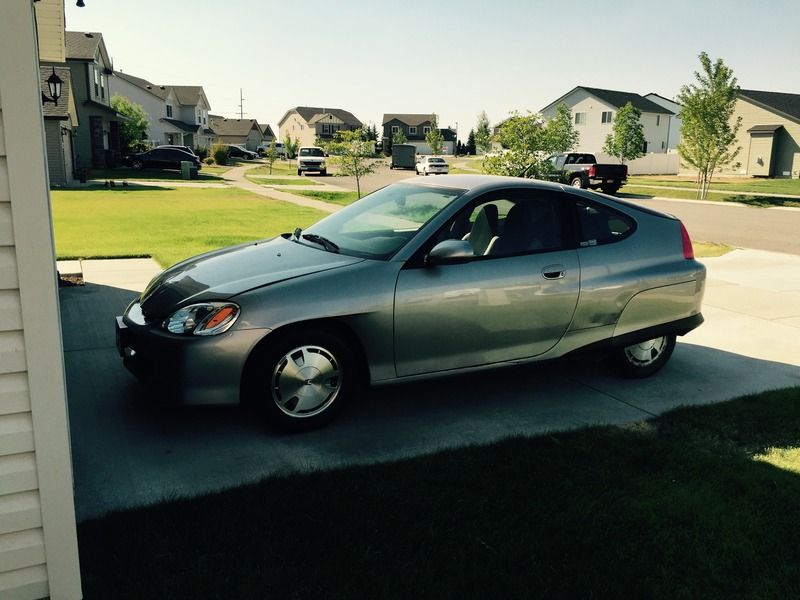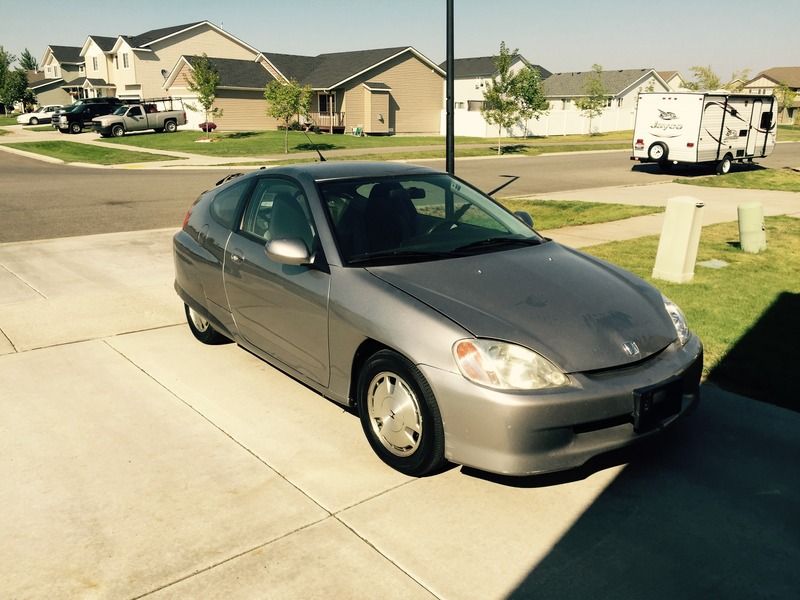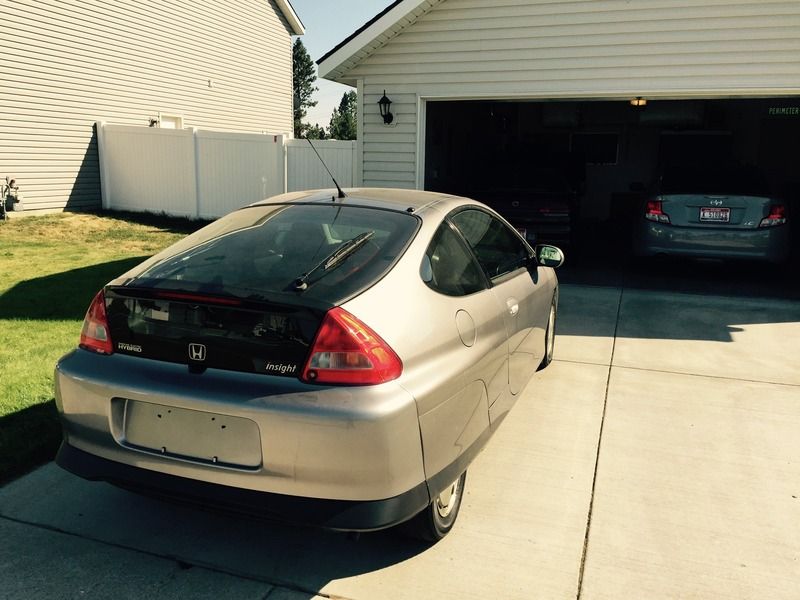 08-23-2015, 12:49 AM
08-23-2015, 12:49 AM
|
#1 (permalink)
|
|
In Lean Burn Mode
Join Date: Apr 2009
Location: Pacific NW
Posts: 1,573
Thanks: 1,351
Thanked 628 Times in 408 Posts
|
Insight into the Future
Well I'm starting my new build, 2000 Honda Insight.
I just purchased this today August 29th 2015.



Did some test driving today and had a blast!!!
Still learning how to eco drive this thing.  Everything seems to be working great, lean-burn, IMA assist, etc.
My plans are to go through everything and eventually do a rear mount turbo, that will have a generator/motor on the turbine side. I also want to incorporate waste solvent fuel like I did on my Talon. I'm not going to mess with the computer for now. 
I'm also going to purchase a extra engine to dissect and see what improvements can be made?
The car needs some body work and a repaint. The interior is in great shape but could use some cleaning and a new carpet. The under body panels are all there but some need some Love.
Anyway here we go!!!
__________________
Pressure Gradient Force
The Positive Side of the Number Line

|
|
|

|
|
The Following 9 Users Say Thank You to pgfpro For This Useful Post:
|
|
 Today Today
|
|
|
|
 Other popular topics in this forum...
Other popular topics in this forum...
|
|
|
|
 08-23-2015, 01:58 AM
08-23-2015, 01:58 AM
|
#2 (permalink)
|
|
Master EcoModder
Join Date: Jan 2014
Location: Antwerp (Belgium)
Posts: 272
Thanks: 10
Thanked 64 Times in 51 Posts
|
Quote:
Originally Posted by pgfpro

Well I'm starting my new build, 2000 Honda Insight.
I just purchased this today August 29th 2015.
|
The 29th?
You sire are from the future!
As i recall. Today it is the 23th....
__________________
Drive smart, save fuel, save money, spare the enviroment
But keep having fun!
I can drift 


Previous car. SUV. From 2011 + 10l/100km to 2017 5,516l/100km.
2017 without holiday: 5,397l/100km
EPA Rated average: 8,1l/100km
Current ride: plug in 285hp hybrid
EPA Rated average: 2,8l/100km
|
|
|

|
|
The Following User Says Thank You to TimV For This Useful Post:
|
|
 08-23-2015, 02:36 AM
08-23-2015, 02:36 AM
|
#3 (permalink)
|
|
In Lean Burn Mode
Join Date: Apr 2009
Location: Pacific NW
Posts: 1,573
Thanks: 1,351
Thanked 628 Times in 408 Posts
|
Quote:
Originally Posted by TimV

The 29th?
You sire are from the future!
As i recall. Today it is the 23th....
|
Crap!!! Thanks for the correction.lol 
__________________
Pressure Gradient Force
The Positive Side of the Number Line

|
|
|

|
 08-23-2015, 02:44 AM
08-23-2015, 02:44 AM
|
#4 (permalink)
|
|
Master EcoModder
Join Date: Jan 2012
Location: United States
Posts: 1,756
Thanks: 104
Thanked 407 Times in 312 Posts
|
Quote:
Originally Posted by pgfpro

My plans are to go through everything and eventually do a rear mount turbo, that will have a generator/motor on the turbine side. I also want to incorporate waste solvent fuel like I did on my Talon. I'm not going to mess with the computer for now. 
I'm also going to purchase a extra engine to dissect and see what improvements can be made? |
Unless it's REALLY cheap to get an engine, I wouldn't get a spare. The best you can do is probably raise compression ratio, then keep a jug of E85 on you as anti-knock additive.
Also a rear mount turbine generator would be ineffective for increasing efficiency, you want it before the cat. You probably want to modify the turbine housing for reduced backpressure.
An easier way to collect waste energy from the exhaust would be this: http://www.alphabetenergy.com/product/powermodule/
If you use that AND a turbine, you'd be looking at some ridiculously high thermal efficiency though. |
|
|

|
|
The Following 2 Users Say Thank You to serialk11r For This Useful Post:
|
|
 08-23-2015, 04:04 AM
08-23-2015, 04:04 AM
|
#5 (permalink)
|
|
Master EcoWalker
Join Date: Dec 2012
Location: Nieuwegein, the Netherlands
Posts: 4,005
Thanks: 1,716
Thanked 2,252 Times in 1,458 Posts
|
Quote:
Originally Posted by serialk11r

An easier way to collect waste energy from the exhaust would be this: PowerModule- |
Nice find!
Just a few things with that:
- The minor pressure drop (9.3 mbar in the example) means you lose about 6000 Joule pushing the 6.3 cubic meter of hot exhaust gas through, so the increased back pressure would cost you about 100 Watt of engine power.
- Key data like weight, size and cost are not listed.
- The need for coolant means you need a separate radiator and pump or a way to link it with the current radiator. It could use the back flow from the main radiator, but you need to either tweak the radiator valve to be stuck permanently open or have separate pump to flow the output of the module to the hot end of the radiator. It might even be necessary to keep pumping a while after engine off...!
- As the module needs to be located behind the last cat it means very long coolant lines. It may be hard to find space for it, not knowing its size.
- You obviously need a voltage regulator. It could back feed the hybrid pack on a hybrid car but will seldom match up nicely. Or it could feed a 12 V converter and be used as an alternator replacement.
All in all this is the most useable exhaust heat recovery system for car use I've seen so far.
If anyone developes complete installment kits for common makes it might take off big.
__________________
2011 Honda Insight + HID, LEDs, tiny PV panel, extra brake pad return springs, neutral wheel alignment, 44/42 PSI (air), PHEV light (inop), tightened wheel nut.
  lifetime FE over 0.2 Gigameter or 0.13 Megamile.

For confirmation go to people just like you.
For education go to people unlike yourself.
|
|
|

|
 08-23-2015, 05:14 AM
08-23-2015, 05:14 AM
|
#6 (permalink)
|
|
It's all about Diesel
Join Date: Oct 2012
Location: Porto Alegre, Rio Grande do Sul, Brazil
Posts: 13,042
Thanks: 0
Thanked 1,723 Times in 1,537 Posts
|
Quote:
Originally Posted by pgfpro

My plans are to go through everything and eventually do a rear mount turbo, that will have a generator/motor on the turbine side. I also want to incorporate waste solvent fuel like I did on my Talon. I'm not going to mess with the computer for now. 
I'm also going to purchase a extra engine to dissect and see what improvements can be made? |
A rear-mounted turbo takes more time to start generating boost, but due to the longer plumbing required to deliver the charged air to the intake there is more area to dissipate the heat developed during the compression. Anyway, have you ever considered to make an exhaust-driven air conditioner similar to the ones used nowadays in most modern airliners?
Trying solvents as fuel I would be kinda worried about lube oil contamination.
Which features do you already consider to upgrade if you eventually get an extra engine to mess with? Would you eventually consider to get an engine from another brand to swap into the Insight? |
|
|

|
 08-23-2015, 05:23 AM
08-23-2015, 05:23 AM
|
#7 (permalink)
|
|
Master EcoModder
Join Date: Jan 2012
Location: United States
Posts: 1,756
Thanks: 104
Thanked 407 Times in 312 Posts
|
Quote:
Originally Posted by RedDevil

Nice find!
Just a few things with that:
- The minor pressure drop (9.3 mbar in the example) means you lose about 6000 Joule pushing the 6.3 cubic meter of hot exhaust gas through, so the increased back pressure would cost you about 100 Watt of engine power.
|
Remember these are meant for semis producing a continuous several hundred hp, on an Insight the backpressure would be insignificant.
Quote:
|
- Key data like weight, size and cost are not listed.
|
Yea, and I think it's probably too big but the thermoelectric units themselves are finally viable and it might be possible to convince them to send some test units not in an assembly for a price.
Quote:
|
- The need for coolant means you need a separate radiator and pump or a way to link it with the current radiator.
|
The way to go is probably a larger radiator and plumb the water coming out to cool the generators, since there's a substantial heat load.
Quote:
- As the module needs to be located behind the last cat it means very long coolant lines. It may be hard to find space for it, not knowing its size.
- You obviously need a voltage regulator. It could back feed the hybrid pack on a hybrid car but will seldom match up nicely. Or it could feed a 12 V converter and be used as an alternator replacement.
|
These are pretty easy, plenty of mid/rear engine cars have used not only long coolant lines but long hydraulic lines (not that it's a good thing). For conversion, you probably wire the TEGs in series for ~15V or so, use a boost converter to have it constantly charging the hybrid battery, and running some of the 12V electrical load in parallel.
When this technology matures I really hope we can start seeing it from the OEM. If that doesn't happen I'm going to figure out a way to get a hold of some and build one myself, one day... |
|
|

|
 08-23-2015, 07:36 AM
08-23-2015, 07:36 AM
|
#8 (permalink)
|
|
Master EcoModder
Join Date: Oct 2011
Location: ellington, ct
Posts: 831
Thanks: 44
Thanked 104 Times in 80 Posts
|
Seems to me that anything on the exhaust side would consume more power than it generates unless existing exhaust components such as the muffler are moved.
Has anyone considered a turbine generator on the input side to generate power? It may be less power, but, seeing as a gas ICE needs that restriction anyway, why not put it to use? If you really wanted to get fancy, it could double as a modest turbocharger.
|
|
|

|
 08-23-2015, 07:37 AM
08-23-2015, 07:37 AM
|
#9 (permalink)
|
|
Master EcoWalker
Join Date: Dec 2012
Location: Nieuwegein, the Netherlands
Posts: 4,005
Thanks: 1,716
Thanked 2,252 Times in 1,458 Posts
|
Quote:
Originally Posted by serialk11r

When this technology matures I really hope we can start seeing it from the OEM. If that doesn't happen I'm going to figure out a way to get a hold of some and build one myself, one day...
|
All true.
What I saw from testing my own small TEG is that the voltage is anything but constant (it varies with the temp difference, obviously); also the power output from said small TEG was too tiny to bother with.
Much better at cooling/heating than at converting a temp difference back to electricity.
A MPPT voltage regulator as used with solar panels is the way to go imho.
It will be some time before the weight/cost/complexity of this would be overcome to a level where it can compete against a battery pack, charged at home or by a solar panel on the roof/hood. Which is what I'm busy with now 
__________________
2011 Honda Insight + HID, LEDs, tiny PV panel, extra brake pad return springs, neutral wheel alignment, 44/42 PSI (air), PHEV light (inop), tightened wheel nut.
  lifetime FE over 0.2 Gigameter or 0.13 Megamile.

For confirmation go to people just like you.
For education go to people unlike yourself.
|
|
|

|
 08-23-2015, 07:42 AM
08-23-2015, 07:42 AM
|
#10 (permalink)
|
|
It's all about Diesel
Join Date: Oct 2012
Location: Porto Alegre, Rio Grande do Sul, Brazil
Posts: 13,042
Thanks: 0
Thanked 1,723 Times in 1,537 Posts
|
Quote:
Originally Posted by pete c

Seems to me that anything on the exhaust side would consume more power than it generates unless existing exhaust components such as the muffler are moved.
Has anyone considered a turbine generator on the input side to generate power? It may be less power, but, seeing as a gas ICE needs that restriction anyway, why not put it to use? If you really wanted to get fancy, it could double as a modest turbocharger.
|
Turbochargers are often quoted to provide some noise suppression, and nowadays that water-cooling is a common feature on them it may also be useful to provide some heat recovery. Possibilities seem nearly infinite...
|
|
|

|
|